Coast Guard Dodges Big Trump Budget Bullet; But Coasties Fix Roofs
Posted on
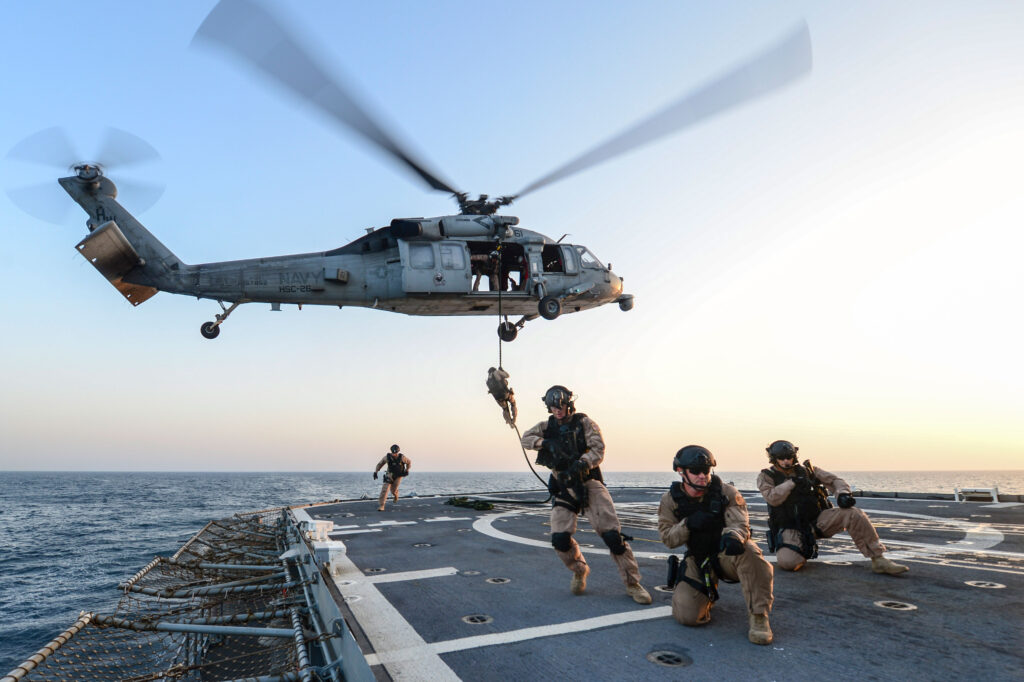
Coast Guard Advanced Interdiction Team training.
WASHINGTON: The White House has dropped plans for a 14 percent cut to the Coast Guard, instead promising a budget that “sustains current funding levels.” The bad news is that “current funding levels” are already too low. The Coast Guard has to give almost 600 drug shipments a pass each year because they don’t have the ships or planes to catch them — and that’s their top-priority mission. Elsewhere, the Coast Guard has cut corners on everything from patrolling the Pacific, to maintaining its bases and to working with the Navy, the Coast Guard Commandant told reporters today.
“Where we’ve seen the most pain is we’ve deferred a lot of our shore (facilities) maintenance,” Adm. Paul Zukunft told the Defense Writers’ Group. “We have a lot of our crew who are out there, if they’re not out doing operations, then they’re fixing utilities, they’re patching roofs.” It took Hurricane Sandy battering the Coast Guard Academy to free up necessary funding for repairs there, he said: “That’s no way to run a railroad.”
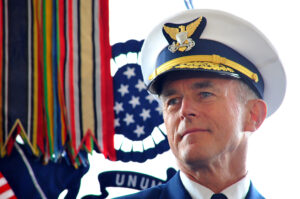
Adm. Paul Zukunft
Another asset wearing thin is the nation’s only heavy icebreaker, the Polar Star. The 40-year-old ship is “on life support” until a replacement arrives in 2023, Zukunft said, but it still has to break “chunks of ice the size of a Metro bus,” so after each deployment it needs a lot of time in the shipyard. Between deployments and overhauls, he said, “that crew is going to be away from home over 200 days this year.”
There appears to be an end in sight. The 2017 budget includes $1 billion in Navy funding to start the new icebreaker. The Coast Guard’s own modernization account rose to $2 billion last year with the addition of a ninth National Security Cutter. (The 14 percent cut would have cancelled it). Construction continues on the smaller Offshore Patrol Cutters and Fast Response Cutters.
All told, Zukunft said, “on the acquisition front I’m extremely optimistic.” It is operations and maintenance that have him worried — especially if Congress keeps passing long-term Continuing Resolutions instead of regular spending bills. “My greatest concern right now is a CR,” he said. “If we don’t have an appropriation in 2017, I will have to shut down operations…. Your only variable expense is fuel, (so) you stop flying, you stop sailing.”
A big part of the problem is the Coast Guard’s unique status as an armed service that’s not part of the Defense Department, Zukunft argues. That problem became particularly acute with the Budget Control Act of 2011, which set strict caps on federal discretionary expenditures (but not entitlements), one cap for defense spending and one for everything else, with the Coast Guard being part of the everything else. “Most of our budget — 96 percent — is non-defense discretionary (funding),” Zukunft said. “The irony is on any given day, I’ll have upwards of 20 ships serving in support of the (military’s) Combatant Commanders. Ships that are bought by, maintained by, and crewed and by non-defense discretionary funding. Yet we are an armed service. So we find ourselves in this no-man’s land.”
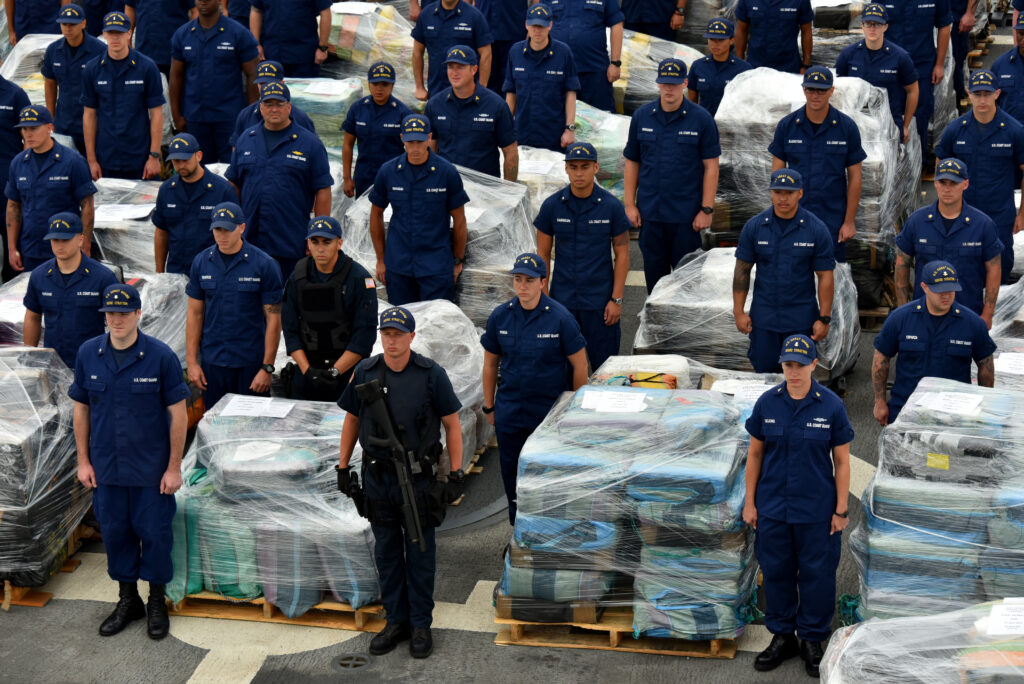
The crew of a single Coast Guard cutter, the Stratton, seized 34 tons of cocaine.
Unique Powers, Unique Problems
On the upside, however, the Coast Guard’s unique status lets it do things no other federal agency can, combining the Title 10 authorities of an armed service with the Title 14 authorities of law enforcement. In particular, the Coast Guard has international agreements with 60 countries that permit the US to board their ships on the grounds of “reasonable suspicion” and even to enter their territorial waters to do so. That’s why there’s an elite Coast Guard Advanced Interdiction Team assigned to Central Command (CENTCOM) in the Mideast. It’s trained and equipped to military Special Operations standards but possesses much greater legal authority to board and search suspicious vessels in times of peace. Around the world, naval vessels conducting boarding operations often carry Law Enforcement Detachments (LEDETs) of Coast Guard personnel.
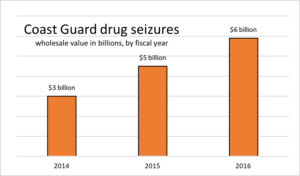
Source: US Coast Guard
Coast Guard counter-terrorism teams also protect the President’s frequent retreats to Mar-a-Lago, such as his recent summit with Chinese president Xi Jinping. Boat teams protect both the Atlantic and Intracoastal Waterway sides of the property, while helicopters keep drones and other low-fliers out of the airspace above. That all comes out of the existing Coast Guard budget. “Is there a supplemental to support this?” he asked. “The answer is no.”
So there are some missions the Coast Guard just can’t afford to do. “Probably our biggest missed opportunity right now is in enforcing fisheries out to 200 miles (i.e. the Exclusive Economic Zone) and beyond,” Zukunft said. In the Pacific, for example, there are small island nations that rely on the US to protect their fishing grounds, often their only economic asset, Zukunft said: “They are ripe for plunder because they don’t have a coast guard, they don’t have a navy.” The Coast Guard has also declined European requests for assistance with mass migration of Syrian war refugees across the Mediterranean.
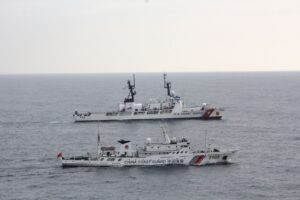
US and Chinese Coast Guard vessels operate jointly against illegal fishing in the Pacific.
The Coast Guard has been able to increase its efforts in the Arctic, to include building a relationship with its Russian counterparts relatively untroubled by rising tensions between the two countries. In fact, the recently created Arctic Coast Guard forum will hold an international search and research exercise in September. “We’re going to use search and rescue (exercises) to nurture this relationship rather than a Freedom of Navigation exercise,” Zukunft said, which could raise tensions. Zukunft has also proposed a permanent Coast Guard presence in the contested waters of the Western Pacific, where the Chinese Coast Guard, not its navy, plays the leading role in asserting Beijing’s territorial claims.
All these global efforts, however, take second place to stopping illegal drugs in the Americas. In the past, the Coast Guard tried to spread resources more evenly among missions, like “peanut butter,” Zukunft said. Today it’s accepting risk elsewhere to cover the Caribbean and Eastern Pacific as densely as it can. Meanwhile Navy ships have largely pulled out, though the larger service provides some support in form of coastal patrol boats (PCs) and P-3 Orion scout planes.
On the Coast Guard’s part, Zukunft said, “we have more than doubled the number of ships, the number of resources we have devoted to this part of the world.” Seizures of cocaine have more than doubled since 2014, from under 100 tons to more than 200 tons. Yet at the same time, year after year, the Coast Guard still ends up getting intelligence on far more shipments than it has forces to intercept.
“We have an awareness of over 80 percent of the maritime flow of the drugs in the Eastern Pacific,” Zukunft said. “Last year, with all that awareness, there were 580 events that we had at least one level of information on that we just did not have enough ships or enough planes to track those down.”

Source: US Coast Guard
Subscribe to our newsletter
Promotions, new products and sales. Directly to your inbox.
